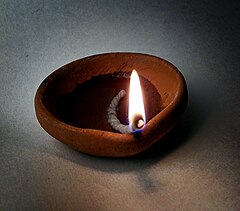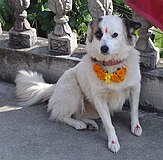Tihar (festival)
| Tihar | |
|---|---|
 | |
| Also called | Swonti (Nepal Bhasa), Deepawali (दीपावली), Yamapanchak (यमपञ्चक), Dewali ( दिवालि ) |
| Type | Religious, Nepali |
| Celebrations | Decorating homes with lights, singing, dancing, gambling, etc. |
| Observances | Prayers and religious rituals |
| Date | New moon day of Kartika, celebrations begin two days before and end two days after that date |
| Related to | Diwali, Swanti |
Tihar (Template:Lang-ne), also known as Deepawali and Yamapanchak, is a five-day-long Hindu festival celebrated in Nepal and in the Indian states of Assam and Sikkim including in Darjeeling district of West Bengal. It is the festival of lights, as diyas are lit inside and outside the houses to make it illuminate at night. It is popularly known as Swanti among the Newars and as Deepawali among Madhesis.[2] Set in the Vikram Samvat calendar, the festival begins with Kaag Tihar in Trayodashi of Kartik Krishna Paksha and ends with Bhai Tika in Dwitiya of Kartik Sukla Paksha every year.[3]
Tihar is the second biggest Nepalese festival after Dashain. It is considered to be of great importance as it shows reverence to not just the humans and the gods, but also to the animals like crows, cows and dogs that maintain an intimate relationship with humans. People make patterns on the floor of living rooms or courtyards using materials such as colored rice, dry flour, colored sand or flower petals outside of their house, called Rangoli, which is meant to be a sacred welcoming area for the gods and Goddesses of Hinduism mainly Goddess Laxmi.[4]
Kaag Tihar (Day 1)
The first day of the festival is called Kaag Tihar.[5] Crows and ravens are worshiped by offerings of sweets and dishes placed on the roofs of houses. The cawing of crows and ravens symbolizes sadness and grief in Hinduism, so devotees offer crows and ravens food to avert grief and death in their homes. Tihar among Gorkhas represents the divine attachment between humans and other animals.
Kukur Tihar (Day 2)

The second day is called Kukur Tihar.[6] It is called the Khicha Puja by the Newars.[7] People offer garlands, tika and delicious food to dogs and acknowledge the cherished relationship between humans and dogs.
Dogs occupy a special place in Hindu mythology. As mentioned in the Mahabharata, Bhairava, a fierce manifestation of Lord Shiva, had a dog as a vahana (vehicle). Yama, the god of death, is believed to own two guard dogs – each with four eyes. The dogs are said to watch over the gates of Naraka, the Hindu concept of Hell.[8] Owing to this belief, this day is also observed as Naraka Chaturdashi.
Gai Tihar and Laxmi Puja (Day 3)


The morning of third day is Gai Tihar (worship of the cow). In Hinduism, cow signifies prosperity and wealth. In ancient times people benefited a lot from the cow. Its milk, dung, even urine was used for purposes like purification. Thus, on this day people show their gratefulness to the cow by garlanding and feeding them with the best grass. Houses are cleaned and the doorways and windows are decorated with garlands made of sayapatri (marigolds) and makhamali (Gomphrena globosa) flowers.
In the evening Laxmi, the goddess of wealth is thanked for all the benefits that were bestowed on the families by lighting oil lamps (Diyo) or candles on doorways and windows to welcome prosperity and well being. At night the girls enjoy dancing and visiting all the houses of the neighborhood with musical instruments singing and dancing known as Bhailo all night long collecting money as tip from houses and share the bounty amongst themselves.
From the third day onward tihar is celebrated with Deusi and Bhailo with light and fireworks. Deusi is mostly sung by the boys while the Bhailo is sung by the girls. Deusi is balladic and tells the story of the festival, with one person narrating and the rest as the chorus. In return the home owners give them money, fruit and selroti (a Nepali roundel made of rice flour and sugar). Nowadays social workers, politician, and young people visit local homes, sing these songs, and collect funds for welfare and social activities.
Coincidentally, Laxmi Puja also marks the birthday of Laxmi Prasad Devkota, who is widely revered and honoured as the greatest poet of Nepali language.

Govardhan Puja (Day 4)

On the fourth day of Tihar, there are three different known pujas, depending on the people's cultural background. It is observed as Goru Tihar or Goru Puja (worship of the oxen). People who follow Vaishnavism perform Govardhan Puja, which is worship towards goverdhan mountain. Cow dung is taken as representative of the mountain and is worshiped. Additionally, majority of the Newar community on the night perform Mha Puja (worship of self). This day is seen as the beginning of the new Nepal Sambat calendar year.
Bhai Tika (Day 5)
The fifth and last day of Tihar is called Bhai Tika or Kija Puja. It is observed by sisters applying tika to the foreheads of their brothers to ensure long life and thank them for the protection they provide. It is believed that Yamraj, the God of Death, visited his sister, Goddess Yamuna, on this day during which she applied the auspicious tika on his forehead, garlanded him and fed him special dishes. Together, they ate sweets, talked and enjoyed themselves to their hearts' content. Upon parting, Yamraj gave Yamuna a special gift as a token of his affection and, in return, Yamuna gave him a lovely gift which she had made with her own hands. That day Yamraj announced that anyone who receives tilak from his sister will never die on that day.
Sisters make a special garland for their brothers from a flower that wilts only after a couple of months, symbolizing the sister's prayer for her brother's long life. Brothers sit on the floor while their sisters perform their puja. The puja follows a traditional ritual in which sisters circle brothers, dripping oil on the floor from a copper pitcher and applying oil to their brother's hair, following which a seven-colour tika is applied on the brother's forehead. Next, brothers give tikas to their sisters in the same fashion with an exchange of gifts. This ritual is practised regardless of whether the brother is younger or older than the sister. Those without a sister or brother join relatives or friends for tika. This festival strengthens the close relationship between brothers and sisters.
In addition to these, Newars make colourful Ashtamangala mandalas and recite chants and procedures in accordance with Tantric rituals. Along with the seven-coloured tika, sisters provide brothers with Sagun, sweets, Makhamali (Gomphrena globosa) garland, and a sacred cotton thread of Tantric importance, similar to Janai thread meant to protect their bodies.
References
- ^ "Nepal Public Holidays 2012 (Asia)". qppstudio.net. Retrieved 2016-09-29.
- ^ Toffin, Gerrard (2007). The Mwahni (Dasai) Festival and the Caste System. Social Science Baha. p. 316. ISBN 978 99933 43 95 0.
- ^ "Tihar begins, Kaag Tihar today". The Kathmandu Post. 28 October 2016. Retrieved 31 October 2016.
- ^ Selvamony 2006, pp. 172
- ^ "Tihar begins; Kaag Tihar today". The Himalayan Times. 28 October 2016. Retrieved 31 October 2016.
- ^ "Kukur Tihar being observed across the nation". The Himalayan Times. 29 October 2016. Retrieved 31 October 2016.
- ^ George van Driem (1993). A grammar of Dumi, Volume 10 (illustrated ed.). Walter de Gruyter. p. 404. ISBN 978-3-11-012351-7.
- ^ "Yama, the First Man, and King of the Dead". sacred-texts.com. Retrieved 29 October 2016.
